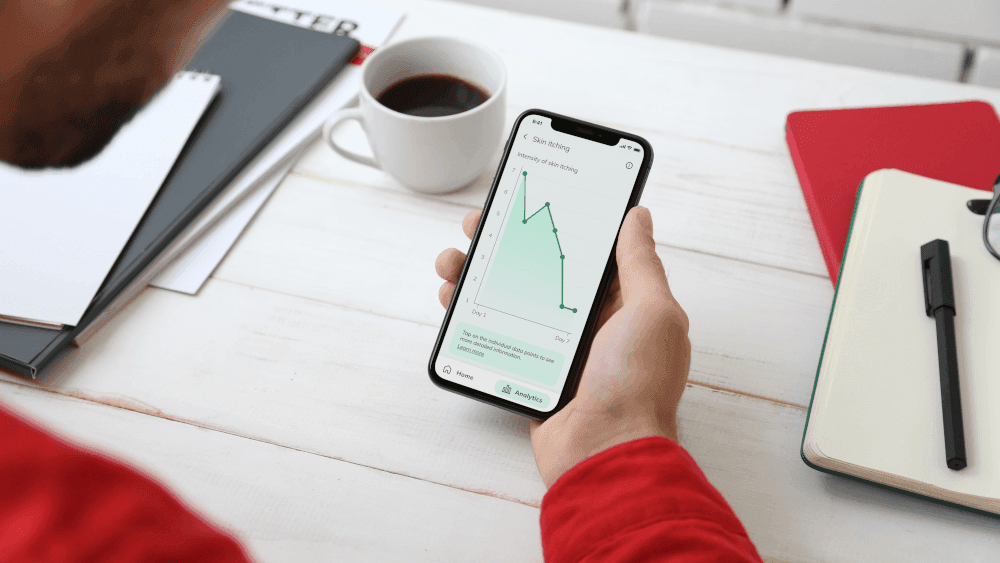Medical Wearables in Clinical Trials: Challenges and Opportunities

DATE
March 31, 2022
AUTHOR
Tereza | Senior Customer Success Manager
Wearables were originally developed for the lifestyle segment – e.g. as fitness watches, AR glasses or smart earphones. But their benefits are also increasingly being recognized in the healthcare sector. Our blog article on the top 5 healthcare wearable trends for 2022 provides an overview of the useful devices from a medical perspective.
Within healthcare, one area of application particularly benefits from the use of medical wearables: clinical trials. The smart devices can collect real-world data (RWD), for example, which enables a more objective and comprehensive assessment of patients’ health status than questionnaires. They also engage subjects more actively in the study process and reduce the need for regular doctor visits, which means a win-win situation for both sides. No wonder that the global market for healthcare wearables is expected to grow to $30.1 billion by 2026.
But how are medical wearables used in healthcare in the first place? Which requirements do the devices have to meet and what opportunities does this open up specifically for conducting clinical trials? We will answer these questions in the following article.
What’s it about?
1. Medical wearables – a win-win for the healthcare sector
2. Increasing use of AI data analytics in clinical trials
3. Challenges in the use of medical wearables
1) Medical wearables – a win-win for the healthcare sector
According to ClinicalTrials.gov, as of March 2022, more than 1,550 trials have been conducted worldwide using medical wearables,, and about a third of them have already been completed. The more extensive the required data, the more studies can benefit from wearables. This is because they reduce the number and scope of patient reports and examinations. In addition, they offer the opportunity to conduct long-term monitoring that would otherwise not be feasible with traditional medical means.
In recent months, medical wearables have found increased use in Covid-19 research as well. Especially in the case of easily transmissible diseases, they reduce the risk of infection for staff and patients thanks to contactless monitoring. In Germany, for example, the Corona data donation app has been in use since April 2020. It uses the sensors of fitness wristbands and smartwatches to obtain indications of the number of people who have contracted the disease and thus identify hotspots more quickly.
But wearables have proved their value in other disease areas, such as asthma, cancer, diabetes and mental illness. They can be used as so-called event recorders, for example, to record cardiac arrhythmias and screen patients for atrial fibrillation. In the “WeSeniMuS” project (Wearable Sensors in Multiple Sclerosis), on the other hand, medical wearables are used to continuously monitor the health of patients suffering from multiple sclerosis.
These examples are just a few of the many possible applications.
2) Increasing use of AI data analytics in clinical trials
Patient participation and clinical data collection are critical factors in the success of trials. However, in order to derive value from the wealth of raw data that is increasingly being obtained through wearables, it must be evaluated and analyzed. The biggest hurdle here is that technological progress is causing the volume and complexity of the data to increase exponentially. Artificial intelligence (AI) is therefore already being used in healthcare to analyze large data sets for specific patterns. So-called deep learning is particularly useful here: This is a form of machine learning where the AI independently observes increasingly complex features and relates them to one another.
For example, Deep Learning has been used to design a real-time wearable warning system for epilepsy seizures. The algorithm identifies individual symptoms that precede a seizure and can thus warn wearers in good time. For diabetes patients, on the other hand, an AI-based system for continuous glucose monitoring was developed, which warns of fluctuations in blood glucose levels up to 60 minutes in advance.However, the use of AI in clinical trials is not only beneficial for the monitoring of RWD and its evaluation. The recruitment and retention process also benefits from AI tools based on Deep Learning and linguistic data processing (Natural Language Processing/NLP). Corresponding algorithms can use the data to identify suitable patients for a specific study, for example, and send a notification to their medical wearables or suggest them directly to the staff. In addition, compliance with criteria can be checked and proactive measures can be taken to motivate patients to participate conscientiously.
Playbook: 4 Advantages of Wearables in Healthcare
Learn more about how patients and the healthcare industry can benefit from wearables:
- Improved patient centricity
- Healthcare with real-time data
- Earlier detection and improved diagnosis
- Resource, cost- and time savings

3) Challenges in the use of medical wearables
There are already countless wearables available in the consumer and lifestyle segment. These are often not certified as medical devices, however, and can therefore not necessarily be used for healthcare applications. Requirements for medical technology include, for example, strict regulations for materials used and high safety as well as data protection standards. It should be noted that certification for medical use depends heavily on local regulations in different countries. Medical wearables approved in the USA can therefore not simply be used in Germany for diagnostic or therapeutic purposes.
In addition to the technical requirements of the wearables, the handling of the data captured also poses a challenge. Ethical and security-related questions about ownership, protection and release of the highly sensitive information for specific purposes must be clarified in advance. The cybersecurity of medical wearables also plays a role here: How long is data stored on the device itself or a linked smartphone? How often and through which channels are they uploaded to the cloud? How well are the data sets encrypted? For each application in clinical trials, the factors must therefore be considered in detail and subjected to a risk-benefit assessment.
Conclusion: Medical wearables open up new opportunities for clinical trials
The use of medical wearables is still in its early stages. We therefore need good collaboration between technology companies and clinical research institutes to master the challenges of both sides and to unite the different demands – in terms of material selection, robustness and measurement accuracy as well as sensor integration, Big Data and cyber security.
For clinical trials, this collaboration promises unimaginable opportunities: From real-time monitoring of disease symptoms and response to drug administration to AI-based data analysis and deep learning, the possibilities seem endless. This trend was also supported by Kaiser Associates in a study for Intel. For example, by 2025, up to 70 percent of all clinical trials will rely on medical wearables. Their use is expected to reduce costs, increase data quality and significantly shorten the processing time until the results are available.
Would you also like to use wearables in your next clinical trial to collect valuable real-world data? Drop us a line! We’d be happy to support you together with our partner network.






